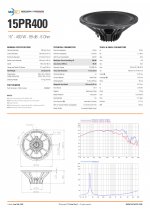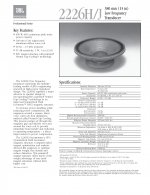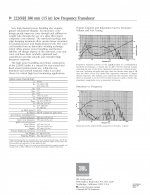Hi Brett,
Could you share some details on this? I am hoarding several of these woofers that I had bought for extremely good price.
Kindest regards,
M
Next design will use a pair [of JBL 2226] a side in a more unusual design, again 3 way, . . ..
Could you share some details on this? I am hoarding several of these woofers that I had bought for extremely good price.
Kindest regards,
M
And your evidence for this is where?I bet, if a string quartet, piano/harpsichord, female vocal or whatever acoustic music is played through both systems, the 15PR400 loaded cab would beat the 2226 cab by a margin.
Sorry, not at this time.Hi Brett,
Could you share some details on this?
Hi Brett,
thank you, no worries.
Kindest regards,
M
Sorry, not at this time.
thank you, no worries.
Kindest regards,
M
Brett, there's no doubt about the quality of JBL drivers.
Personally, I think the importance of shorting rings is overrated (for hifi use).
It's a nice to have feature, not a necessity.
Many people tend to focus on specific technical features, while overlooking the aspects that define the actual sonic performance.
Example.
Build 2 cabs with the same horn/waveguide + comp. driver, one optimized for a 2226, the other for the 15PR400.
XO is 1000Hz and both are tweaked, tuned and voiced to death...
I bet, if a string quartet, piano/harpsichord, female vocal or whatever acoustic music is played through both systems, the 15PR400 loaded cab would beat the 2226 cab by a margin.
I have heard both and the 15PR400 is cleaner and better sounding for sure.
The Mids are way cleaner!
I have heard both and the 15PR400 is cleaner and better sounding for sure.
The Mids are way cleaner!
From very low to 1k? its also 1/3 of the price..
You don't need to actually build the cabs of my example to know how it'll end, just looking at the specs will suffice.
I've heard 2 ways with both drivers.
A guy who lives around my corner has a sh..load of JBL 2226 loaded loudspeakers, JBL branded, Stage Accompany and custom builds.
Make no mistake, the 2226 is a very good driver, but I can predict the comments of classically trained ears on the hypothetical 2 way, crossed at 1000Hz.
They would use adjectives/expressions like: nasal, slow, two-dimensional, lacking dynamics, timbre, midrange resolution, 'air' etc.
That said, other people may actually prefer the sound of the 2226 loaded 2 way, depending on their musical preferences and SPL.
It's obvious why I explicitly referred to acoustic/classical music and classically trained ears.
This topic has been discussed before in this thread and many comments on the (un)suitability of the 2226 for hifi can be found elsewhere.
I've heard 2 ways with both drivers.
A guy who lives around my corner has a sh..load of JBL 2226 loaded loudspeakers, JBL branded, Stage Accompany and custom builds.
Make no mistake, the 2226 is a very good driver, but I can predict the comments of classically trained ears on the hypothetical 2 way, crossed at 1000Hz.
They would use adjectives/expressions like: nasal, slow, two-dimensional, lacking dynamics, timbre, midrange resolution, 'air' etc.
That said, other people may actually prefer the sound of the 2226 loaded 2 way, depending on their musical preferences and SPL.
It's obvious why I explicitly referred to acoustic/classical music and classically trained ears.
This topic has been discussed before in this thread and many comments on the (un)suitability of the 2226 for hifi can be found elsewhere.
Last edited:
From very low to 1k? its also 1/3 of the price..
It depends on what you mean by 'very low'.
In the right cab, it'll cover 35-1000Hz easily, 30Hz or even lower with some room gain.
Still not seeing any evidence, just anecdote of words that have such variability between individuals that they're meaningless outside of the context of that individual. I've had people listen to the same system in the same room at the same time that use vastly different adjectives to describe it. Worthless.Ybut I can predict the comments of classically trained ears on the hypothetical 2 way, crossed at 1000Hz.
They would use adjectives/expressions like: nasal, slow, two-dimensional, lacking dynamics, timbre, midrange resolution, 'air' etc.
Science versus subjective perception, an everlasting debate.
Earlier, examples were cited of 'scientifically' superior loudspeakers that were crunched in practice by theoretically far inferior products (i.e. waveguides vs. diffraction horns).
You seem a knowledgeable and experienced builder.
If you just compare specsheets of both drivers, what's your assessment?
Even from a technical/scientific point of view it's obvious why the 15PR400 is superior >500Hz.
I would (vaguely) suggest: just "read" (analyze) the driver and translate (visualize) its characteristics/specs into "sound".
After a few hundred different loudspeaker systems you'll start to "recognize patterns"
... Or if you still don't believe those who commented on both drivers, just build the cabs and find out for yourself.
Earlier, examples were cited of 'scientifically' superior loudspeakers that were crunched in practice by theoretically far inferior products (i.e. waveguides vs. diffraction horns).
You seem a knowledgeable and experienced builder.
If you just compare specsheets of both drivers, what's your assessment?
Even from a technical/scientific point of view it's obvious why the 15PR400 is superior >500Hz.
I would (vaguely) suggest: just "read" (analyze) the driver and translate (visualize) its characteristics/specs into "sound".
After a few hundred different loudspeaker systems you'll start to "recognize patterns"
... Or if you still don't believe those who commented on both drivers, just build the cabs and find out for yourself.
Last edited:
Why oh why, would the 15PR400 be better in the midrange (>500Hz)?
If you'd just keep looking at the measurement plots on a screen (after building cabs with both drivers),
instead of listening to the builds you may not become convinced, because the 2226 measures flat up to 1000Hz.
Obviously, this won't tell you much about its actual (subjective) sonic performance (apart from the driver technically operating in a 'linear' fashion).
But if you invite classical musicians to listen to both 'optimized' cabs, they would tell you which driver sounds more like 'the real thing'.
If you'd just keep looking at the measurement plots on a screen (after building cabs with both drivers),
instead of listening to the builds you may not become convinced, because the 2226 measures flat up to 1000Hz.
Obviously, this won't tell you much about its actual (subjective) sonic performance (apart from the driver technically operating in a 'linear' fashion).
But if you invite classical musicians to listen to both 'optimized' cabs, they would tell you which driver sounds more like 'the real thing'.
Attachments
Last edited:
I've had people listen to the same system in the same room at the same time that use vastly different adjectives to describe it. Worthless.
If those people were all classically trained professional musicians, I wouldn't attend their performances.
Are you familiar with the concept of 'perfect pitch'?
Last edited:
That they were made many years apart, with different measurement systems, by different people on different continents and aren't comparable.You seem a knowledgeable and experienced builder.
If you just compare specsheets of both drivers, what's your assessment?
No interest in doing so. I have no application for the FP at the moment apart from the unit I'm getting for a possible BG rig, chosen because it was cheap and available locally, and because of an injury, I need to build a much lighter rig. My workshop has a couple of hundred unused drivers already.... Or if you still don't believe those who commented on both drivers, just build the cabs and find out for yourself.
I find the classical musicians argument specious, as I lived with one (a pianist) until she passed as well as met many others through her and they were the worst at system analysis.
Yes. My late wife was gifted with it.Are you familiar with the concept of 'perfect pitch'?
I already own the drivers and have for a long time, so they are effectively free. I could make exactly the same argument about you re the FP.However, if you just want the 2226 to be superior, nothing, not even science, could cure you.
I have nothing against FP drivers. I own 6 and 4 (8HX200) are already used in my surrounds. My point is that I find your arguments unconvincing so far about the relative merits of each.
Somehow, this got missed when replying earlier;
I have compared them subjectively to other drivers; AEs, Volts, PHL amongst others. They were the benchmark to be bested, and they were eventually by the AEs.If you'd just keep looking at the measurement plots on a screen (after building cabs with both drivers),
instead of listening to the builds you may not become convinced, because the 2226 measures flat up to 1000Hz.
The snide ad hom about only measuring and not listening was not necessary.
Last edited:
The snide ad hom about only measuring and not listening was not necessary.
That post was meant as a general comment, not ad hom.
The 'you' would be the average reader of this topic in the 'hypothetical' case.
I am sorry, if you have understood it as such.
Last edited:
I have compared them subjectively to other drivers; AEs, Volts, PHL amongst others. They were the benchmark to be bested, and they were eventually by the AEs.
The AEs are TD15Ms?
- Home
- Loudspeakers
- Multi-Way
- Is it possible to cover the whole spectrum, high SPL, low distortion with a 2-way?



